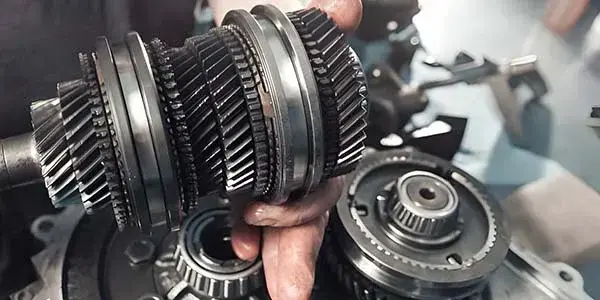What is a Multi-Point Inspection? Do i need it? – Technologist
A multi-point inspection is a procedure of testing and checking all of the components of your vehicle from the inside out. This type of inspection is done by a qualified technician. It is meant to identify any underlying issues that can be risky. Once you figure out the problem inside your vehicle you can manage it very well.
This inspection is color-coded, which will provide you with an idea about which part requires immediate attention. It can save you and your loved ones from bad events. These color codes are as follows:
- Red, a sign of emergency, needs sudden attention
- Yellow, will need attention after some time
- Green, condition is good, You are good to go
What is checked during a multi-point inspection?
The multi-point inspection involves different parts of your vehicle to be checked. They mostly include all of the vehicle parts, especially the ones given below:
Engine Oil
The vehicles that run on gas, contain engine oil that provides lubrication to all the internal engine parts. When an engine is working these parts can cause friction so a certain level of clean engine oil is essential to prevent any damage due to wear and tear. A technician will check for the engine oil whether it is clean and leveled, for a good engine performance.
Coolant
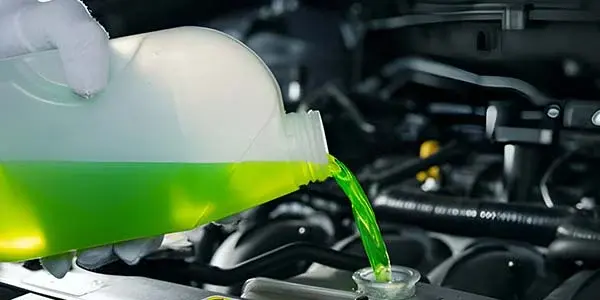
When a vehicle is running, several combustion processes are happening inside the engine. These combustion processes make the engine hot. Coolants are used in vehicles to reduce the effect of heat. The level of coolant and leakage in any pipe of the radiator is accessed. This will help your vehicle from overheating and excessive damage.
Hoses
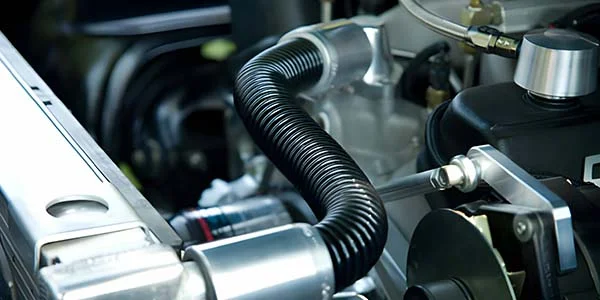
A vehicle engine contains several hoses like rubber and metal hoses. These hoses help the fluid move from its source to the engine parts. Any leakage in these hoses can affect the performance of your vehicle.
Air Filter
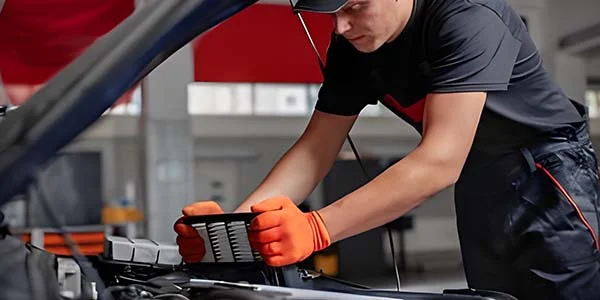
An air filter provides your engine protection against all kinds of dust and dirt. If these particles get into the engine they can affect the engine efficiency. These filters get clogged after some time thats why It is important to maintain a clean air filter.
Battery
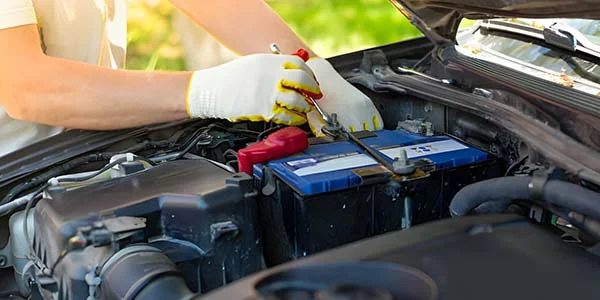
A battery is a source of electricity required to start and run the vehicle. It is not just a plastic box but a house of power containing different metal plates to carry out chemical reactions. These reactions as a result produce electricity or voltage, necessary for running your vehicle. A technician will perform a battery voltage test, which will help him to check the overall health of your vehicle battery. A battery must be in good condition.
Power steering Fluid
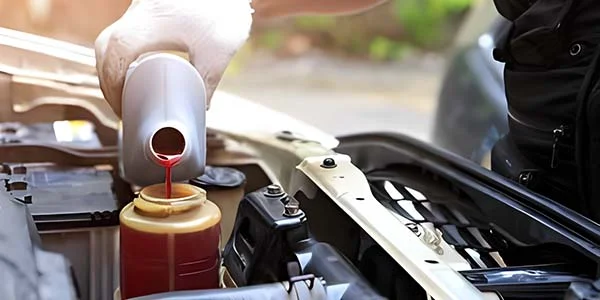
A power steering fluid is used in a power steering system. It is a hydraulic fluid that travels from its storage container towards the power steering. It works in your vehicle by creating pressure inside the fluid and regulating the smooth steering movement. A power steering fluid can get mixed with dirt which reduces its efficiency. A good and clean hydraulic fluid is important but it may leak sometimes so it is important to do a proper inspection.
Brake Fluid
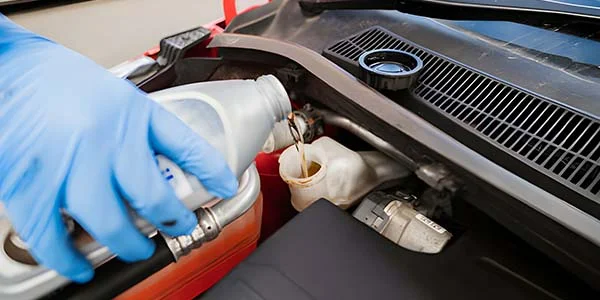
A break fluid is a hydraulic fluid that is present in your brake system. When the driver applies a break by pressing the brake pedal, the pressure shifts from the fluid towards all four wheels. Here, the fluid amplifies the pressure and force to stop your vehicle. Your technician may check the brake fluid and look for signs of any contamination or lower-than-normal levels of this fluid.
Engine Performance
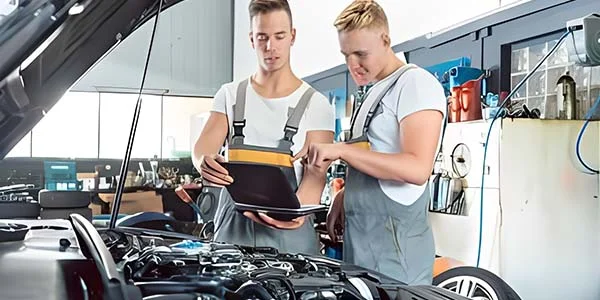
Your engine is checked by different diagnostic tools. A device called an OBD-II scanner is used to detect any damage or malfunction inside the engine. It decodes the engine data by plugging it into the vehicle’s onboard diagnostic port. Similarly, a compression test is used to check the pressure inside the pistons and valves of the engine.
Transmission
A transmission helps to transmit power from the engine to the wheels. Transmission is done by the fluid so a technician will look for any fluid leakage during transmission. There are two types of transmission manual and automatic. If you have an automatic transmission, the transmission must be smooth from one gear to the other. If this is not the case, you need to fix it. But if it’s manual then a technician will also test your vehicle’s clutch.
Exhaust
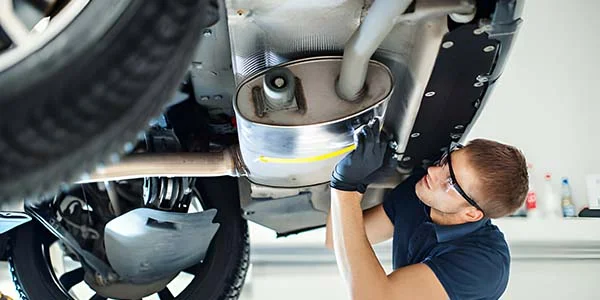
During the combustion of fuel, remaining gases as a by-product leave the vehicle through exhaust. If there is any damage inside the exhaust system, your vehicle may produce noise.
You must never ignore such noises and consult for an inspection.
Other Components
Several other small components are also accessed in a multi-point inspection. Like:
- Lights
- Floor Mats
- Wipers
- Air conditioning
- Horn
- Airbags
- Seat belts
Why should I get a multi-point inspection?
A multi-point inspection can serve many benefits for you and your vehicle. It is good to know the current condition of your vehicle, this can help you identify which problem needs immediate attention. The main goal is to identify the problem and manage it before it gets too risky and costly.
Early Detection
The early detection of your vehicle issues helps you save a lot of money. As time passes and a small problem is not given proper attention or not repaired well, it turns into a bigger problem. Bigger issues need time to fix and require a large amount of budget.
Increased vehicle lifespan
Every vehicle has issues but you need to identify these issues on time. A multi-point inspection can help you identify all kinds of issues your vehicle is going through. Managing these issues will increase the life of your vehicle.
Improved Performance
A qualified technician will check for the brakes, tires, fluid, and other engine components. On examination, if your vehicle has some issues, they can fix them. It improves the performance of your vehicle, especially for longer routes.
Negotiation Leverage
When you are buying a second-hand car, it is necessary to do a multi-point inspection. This will help you to be aware of the issues in your vehicle. Also, this can provide you with a point to negotiate with your dealer.
How much time is required for a multi-point inspection?
A multi-point inspection is a detailed inspection of your vehicle. It involves an examination of brakes, fluids, engine components, tires, lights, in short everything inside and outside of your vehicle. Since it is a long procedure, it can take hours. It is advised to ask your technician how much time it will take.
Conclusion
A multi-point inspection is a safe investment in your vehicle that maintains the vehicle’s health, saves your money, and provides safety for you and your loved ones. It is important to remember that all the points mentioned in this blog are general, these inspection points may differ depending on the service station you choose and the model of your car.
A Reliable Auto Insurance is just as important as a reliable car. Contact us for the best auto insurance rates.
